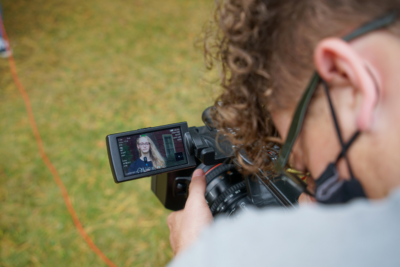Young people find a voice in public media
The COVID-19 pandemic shut down American schools. A month later, the PBS NewsHour aired a segment featuring teenagers from across the country. How were they were dealing with social distancing?
“My teachers have been really flexible, especially with the amount of work they give,” said Isabelle Mesropian from Canyon High School in Southern California. “Honestly, I miss the classroom atmosphere.”
“I’m very upset,” said Salma Valenzuela, a senior at Northside Charter High School in Brooklyn, New York. “The coronavirus took away my senior year. I have been trying to push through.”
Student voices came through in distance learning curriculum created by PBS NewsHour Student Reporting Labs.
PBS NewsHour Student Reporting Labs (SRL) is a national public media initiative. In the program, middle and high school students produce video news stories about big issues facing young people today. SRL was founded in 2009 as an effort to reimagine and redefine young people’s experiences with journalism.
“How can we get more teenagers to care about the news?” Founder Leah Clapman asked after talking to students. They didn’t see people who looked like them, or hear voices that sounded like them. The news was being produced by adults, for adults. Their experiences as young people were not being represented.
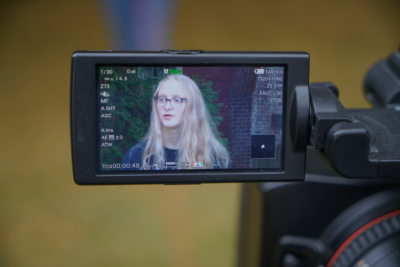 Over 11 years, nearly 100 student-produced or co-produced pieces have aired on the NewsHour to millions of viewers. Dozens more aired on local PBS stations, providing thousands of students with intentional pathways to reach authentic audiences through public media.
Over 11 years, nearly 100 student-produced or co-produced pieces have aired on the NewsHour to millions of viewers. Dozens more aired on local PBS stations, providing thousands of students with intentional pathways to reach authentic audiences through public media.
With programs in more than 165 schools, SRL works with teachers, students and local PBS stations to experiment with innovative ways of teaching and producing video journalism.
Throughout the school year, students pursue news projects tied to national issues, such as the coronavirus pandemic and the presidential election. And they get support from journalism mentors and public media professionals. Project-based learning experiences help students build critical thinking, problem-solving, teamwork and communication skills. They are the essential skills necessary to become informed media creators and consumers in today’s world.
A powerful form of learning and civic engagement
SRL’s ties to public media give young people the tools to create well-informed content, and provides access to unique publishing platforms. Student reporters in the program are engaged with the issues affecting their community. They are empowered to join important conversations.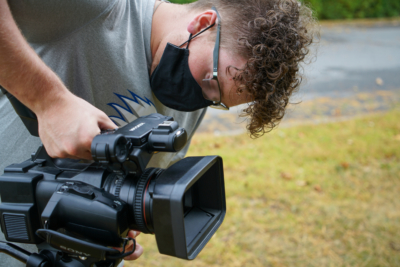
It’s not only valuable for students to frame their world through the stories that surround them in times of crisis, but always. Once journalism students gain an awareness of the potential audience, perspectives change. They recognize that they’re not just spectators, but journalists themselves. Media researcher Henry Jenkins, a professor at the University of Southern California, terms the approach “participatory culture.” School becomes meaningful, and students connect and learn when their work extends beyond the school walls and into greater societal conversations.
When Student Reporting Labs issued a call in 2018 for stories on “public art” and its role in today’s world, Joe Damon, a student from Mid-Maine Technical Center in Waterville, Maine, took a nontraditional approach. He designed a story pitch about tattoos as the new form of public art. The pitch won quick approval from SRL.
While Joe shaped his story with input from his teacher, youth media producers at SRL and suggestions from his peers, it was his vision and sense of editorial style that guided the final story — from the animated title screen to decisions about what to include, and what to cut from the final piece.
“Public Art: Your Own Canvas”
This pieces explores the view of tattoos as public art from young people and a professional tattooist.
Control over editorial style gives students like Joe a sense of ownership. This sense of agency can influence engagement and the ultimate success of a piece of journalism. Shaping a story takes effort, starting with the inception of an idea, through the field work and interviewing, and on to the editing and endless revision.
In 2019, a team of students from Mid-Maine Technical Center (MMTC) produced a four-minute story for Maine Public Television on a student-led groundwater testing study that found high levels of arsenic in drinking water. Interviewing scientists, chemistry teachers and students might not have been a top pick for many young people, but the assignment had two draws:
- A statewide television audience
- A chance for direct mentoring from a local public television producer
Individual style decisions had to be measured against Maine Public’s broadcast standards, and the sense of quality viewers expect from a public television program.
“Maine Spring Live – Clean Water”
The story not only earned its spot in an Emmy-nominated Maine Public program — Maine Spring Live: Science, Nature, and You — it was featured on a website promoted by the popular PBS series, Nature, and scored thousands of views on MMTC’s social media platforms.
Lucas Pelotte, a senior video journalism student, worked on the project. “You had to have your own personal style with it, but it was kind of challenging because it was going on TV,” he said. “It kind of made you want to know it was going to be good.”
Rebecca Conley is the Maine Public producer who worked with the students involved. It was her role was to help the young journalists strike a balance. “Journalism is that fine line. You’re trying to tell a story, but are you trying to tell the story, or can you let the story tell itself? That’s all the magic of editing.”
Connecting skills to career paths
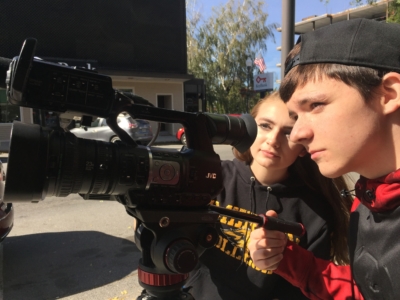 Sometimes the value of public media for young people comes not in its creation, but in its consumption. When SRL debuted its “Making It Work” series, portraying how young people across the country were preparing for careers, students at MMTC were amazed. They were inspired by an entrepreneurial young man in Pennsylvania running his own hog farm. And they found interests in common with a Detroit media producer building a YouTube career.
Sometimes the value of public media for young people comes not in its creation, but in its consumption. When SRL debuted its “Making It Work” series, portraying how young people across the country were preparing for careers, students at MMTC were amazed. They were inspired by an entrepreneurial young man in Pennsylvania running his own hog farm. And they found interests in common with a Detroit media producer building a YouTube career.
Not only did SRL students contribute to the “participatory culture” of our media-rich society, but they gained a sense of how to watch news with a critical eye. They learned to seek out connections where they exist. They learned about what good journalism looks like, as a producer and as a consumer.
There’s a heightened sense of purpose when students work on a Student Reporting Lab project.
Whether they’re interviewing about the youth vote, climate change or adapting to life under stay-at-home orders, students know they are producing for an audience that will care about the message.
That doesn’t mean the classes are free of fun and friendship — far from it. Collaboration becomes even more important, as does attention to detail and a sense of objectivity. Student journalists must make their work stand out from other Student Reporting Labs. When reporting on the youth vote in the final days before the 2018 midterm elections, students at MMTC picked locations they thought highlighted their community. They dressed professionally for working on-camera, and they vetted their own work, making decisions on which interviews to send to PBS for consideration. And then they celebrated as two of their picks made it to national audiences.
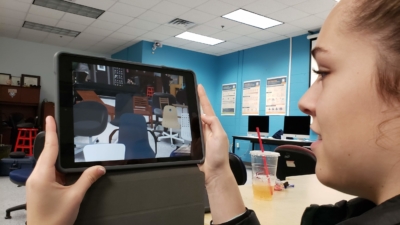 Students could take on the same work without a program like PBS NewsHour Student Reporting Labs. There are always topics to explore, stories to develop. But what changes, when students create for public media is that awareness of audience and the expectation that the end product matters. That means following the basic tenets of journalistic fairness, objectivity and accuracy in telling a story; learning the technical details: sound, exposure, focus, composition; and so much more.
Students could take on the same work without a program like PBS NewsHour Student Reporting Labs. There are always topics to explore, stories to develop. But what changes, when students create for public media is that awareness of audience and the expectation that the end product matters. That means following the basic tenets of journalistic fairness, objectivity and accuracy in telling a story; learning the technical details: sound, exposure, focus, composition; and so much more.
SRL’s curriculum helps students follow a track. First they decipher what makes a meaningful visual piece of journalism, and then they find those stories in local communities. Students start with short interview-based prompts featuring peers within their own classes. Later, they take on more complex, community-based, multi-interview stories that dive deeper into a topic. All through the process, students receive coaching to gain advanced skills in the field.
Students gain real-world experience and credentials.
In Maine, CTE communications students work toward certification endorsed by the Maine Association of Broadcasters, aligned to the state’s CTE standards for multimedia production. In some programs, students can also use their career and technical 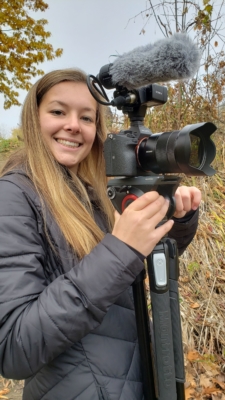 education experience to:
education experience to:
- Meet English language arts or other subject area standards through alignment with the Common Core.
- Earn college credit through a series of robust dual enrollment agreements with state community colleges.
At MMTC, students in the mass media communications program are eligible for internships with local businesses and nonprofits. CTE programs in the SRL network value the real-world connections made from the classroom to possible career paths. Holistic learning experiences give student journalists the training and the authority to speak about issues they see as important while helping them meet the technical and journalistic standards of the industry.
The voices and leadership of young people drive change. As such, experiential learning opportunities like Student Reporting Labs provide valuable entry into a dynamic field.
Elis Estrada and Dave Boardman presented a session — “Helping Young People Find a Voice Through Public Media” — at ACTE’s CareerTech Virtual VISION 2020.
Dave Boardman, Ed.D., NBCT, is instructor of mass media communications at Mid-Maine Technical Center in Waterville, Maine. He has taught multimedia, journalism and language arts for 19 years. Boardman is a professional photographer and video producer with four Emmy nominations. Email him.
Elis Estrada is the senior director for PBS NewsHour Student Reporting Labs. She oversees the development, work and content of SRL’s growing national network of schools and partner public media stations. She loves puzzling through large-scale projects that aim to motivate and inspire students and teachers. Estrada invests deeply in creating fun, educational opportunities for young people to engage with news media. Before joining the NewsHour, she held dual titles at the News Literacy Project, as program manager for the Washington, D.C., region and associate communications director for digital media. Email her.

